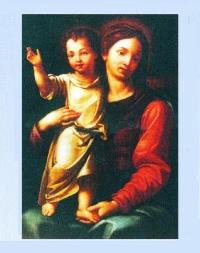
First of all it is necessary to point out that Our Lady of the Sea could be considered
co-Patron Saint of the city, so strong is the devotion felt by the fisher folk for Her and so widespread the effect of celebrations to Her that take place every year on the last Sunday in July.
The Feast, celebrated on 2d July, the day of the Virgin Mary's Visitation, from the seventeenth until late nineteenth century, was only held inside the small church of be Madonna della Marina and in those days there was no procession.
The situation changed in 1870 when a procession was included among the celebrations in honour of the Virgin Mary and since 1872 a fair has been held as well.
Our Lady of the Sea Feast radically changed in 1880/1885 when it shifted to the
an end of July with solemn religious and civil ceremonies.
In the meantime, since the early eighteenth century, every last Sunday in July
"Madonna del Carmine" has been celebrated magnificently, at first only in the streets
in of the "Paese Alto", then extended to the "Marina" area below from the second half of
the nineteenth century.
In the early 1880's Father Giacinto Nicolai, parish priest in the "Paese Alto",
suspended the procession of the Madonna del Carmine because the statue was badly damaged, but in agreement with the Municipality it kept civil ceremonies at the end of on July.
Meanwhile, as already said, in the same period the procession of Our lady of the Sea Feast shifted from the first Sunday of July to the last one in the same month, by was then without the procession of the Madonna del Carmine. Once a new statue of the Madonna del Carmine was made in 1895, this procession was revived although limited to the area of the "Paese Alto" until this ceremony was definitely cancelled in half 1915 with the outbreak of the World War.
In the meantime Our Lady of the Sea Feast was becoming well-known and more and more famous, also for the fact that the bathing establishment was opened and attracted a great number of visitors who increased in number day by day in the summertime. Civil and religious celebrations lasted two days in which San Benedetto ,un was visited by a great number of tourists coming from the whole area of Ascoli Piceno and Teramo, encouraged by special discounts un train tickets. All the city centre and above all the main street (today Corso Mazzini), Viale dell'Ancoraggio (today Viale Secondo Moretti) and the beach welcomed celebrations and festivities. A large cart that carried the statue of Our Lady of the Sea in procession, whilst festival committees organized bicycle or horse rides along the main street and music and lights brightened was up Ancoraggio Avenue. On Sunday aftemuon the lots were drawn un the balcony of rated the City Hall, next to the old church of Madonna della Marina, and the funds raised went to the nursery school, while the best entertainment was organized at the bathing
establishment; in the evening fireworks, on Ancoraggio Avenue and in the public gardens, were set off (and set out by skilled fire-producers from Abruzzi).
o" or After the interruption of the Second World War, all festivities both civil and t was religious were moved East uf the railway station, in the harbuor area, and fireworks are now set out at the south pier. Our Lady of the Sea Feast had only a short pause after the armistice in 1943. The first celebration after the war, although a bit subdued, took place un 29th July 1945. Nowadays Our Lady of the Sea Feast is the main one which characterizes summertime in San Benedetto del Tronto.
(from "San Benedetto del Tronto città adriatica d'Europa" by Giuseppe Merlini)